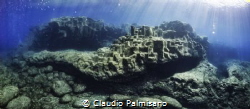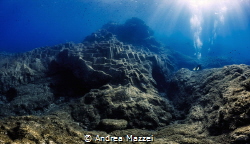Underwater you can't see or photograph large mountains. If you are too close you see just a portion, if you go far away dust, particles and not clean water hide you vision. But, if you take lot of pictures close, and then you stitch these, you have the big vision. I saw and I showed to people form linosa for first time amazing underwater scenarios. This is an huge Columnar Basalt structure. To understand proportions and size, the small dot on left is a diver.
Facts about Linosa It is in Italy
It is in Italy- Linosa is in the Mediterranean Sea.
- The typical depth is 0-20 Metres 0-60 Feet.
- The typical visibility is 30+ Metres 100+ Feet.

by
Claudio PalmisanoHuge panorama, impossible to sea naturally, possible just stitching lot of pictures together. The magic of photography.

by
Andrea MazzeiA panorama shot taken in Linosa, a small volcanic island south of Sicily